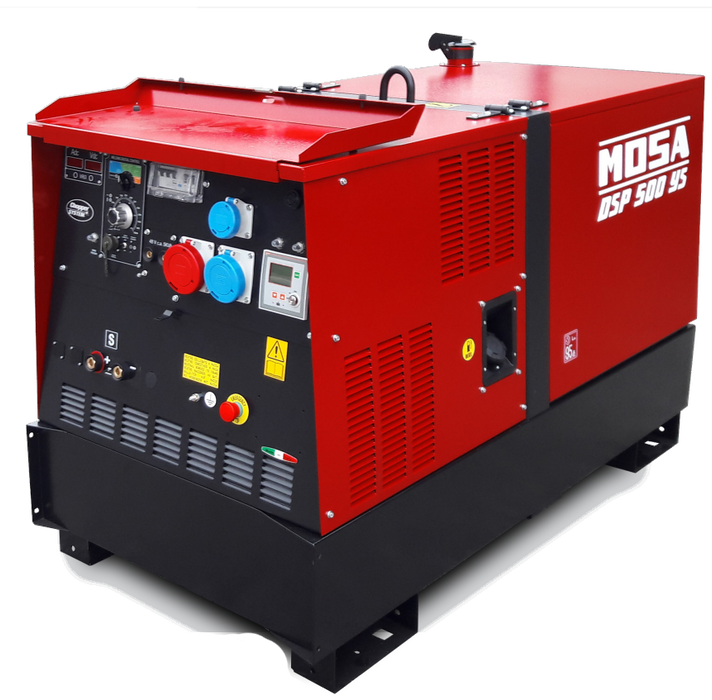
MOSA DSP 500 YS-CC/CV Industrial Engine Driven Welder
Get an Additional Discount!
Simply use the code WELD5 at the checkout to get even more savings when you spend £250 or more...
Warranty Information
All MOSA products come with a 2-Warranty as standard. Click here to find out more
Unsure? Get in touch...
We are always happy to help. If you have any questions or can't find what you are looking for just give us a call on 01375 800761 or email us at sales@toolweld.co.uk
Engine Driven Welder Diesel YANMAR 4TNV88 - Three-phase asynchronous Alternator - Water cooling
WELDING
- Welding current: 20A ÷ 500A
- Welding current electronic regulation: continues on 2 scales: 20A ÷ 250A / 20A ÷ 500A
- Service: 500A - 60% / 450A - 100%
- Open circuit voltage (no-load voltage): 62 Vdc (65 Vdc peak)
POWER RATINGS
- Three-phase power: 16 kVA / 400 V / 23.1 A
- Single-phase power: 10 kVA / 230 V / 43.5 A
GENERAL SPECIFICATION
- Tank capacity: 60 l
- Running time (welder 60%): 19 h
- Measured acoustic power LwA (pressure LpA): 94 dB(A) (69 dB(A) @ 7 m)
- Guaranteed acoustic power LwA (pressure LpA): 95 dB(A) (70 dB(A) @ 7 m)
- Weight: 720 Kg
- Dimensions max. on base Lxlxh: 1720x850x1128 mm
- User interface with symbols, codes and texts.
- Setpoints adjustable via controller buttons or PC
- Remote Start and Stop
- Configurable inputs and outputs
- NFC interface for wireless programming
TECHNOLOGY
The acronym DSP, which is referred to this line of MOSA welders, stands for "Digital Signal Processor", and identifies the fact that the regulation of the welding parameters is performed by means of a digital technique. More precisely, in the DSP controller reside the programs which perform the regulation of the different welding processes supported.
The implementation of the control is accomplished by a power converter of the "Chopper" type (Chopper System), which operates at high frequency (20 kHz).
The high frequency conversion allows to obtain superior welding performances in comparison with more conventional techniques at low frequency.
FEATURES
Via a rotary selector you can choose between 5 different welding programs.
- LIFT ARC TIG – This program performs a TIG welding with a "Lift Arc" start. With this feature the arc is started simply by touching the piece, without scratch.
- STICK (3 PROGRAMS) - They are specific for the electrode welding (CC), being characterized by three different arc force levels with increasing short circuit current from 1 to 3.
- MIG MAG – It is dedicated to WIRE welding, WITH GAS or FLUX CORED. This welding process is performed at constant voltage (CV).
The front panel of the DSP control unit is provided with a military type circular connector which can be connected to a MOSA remote control unit or wire feeder, for MIG MAG. When plugging an external connector the control is automatically switched from the front panel knob to the knob on the remote unit. All the machines of this series are equipped with digital meters to monitor the welding current and voltage. The software of the control unit, depending on the version of welder on which it is installed, can handle various functions, including:
a) Power Optimizer - A function that prevents overloading of the engine during welding
b) VRD - (Voltage Reduction Device) a function that reduces the open circuit voltage to a safe value when not welding
c) Reverse polarity – In the models where this function is present , a switch on the panel commands the contactor which implements the polarity reversal.
The DSP controller also implements some security features:
- Chopper converter overtemperature
- Overcurrent during welding (due to failure or malfunction)
- Current sensor not connected
- Malfunction of the supply voltage



